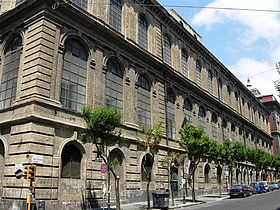Accademia di Belle Arti di Napoli
 Facade of the main academy building on Via Santa Maria di Costantinopoli | |
Former names |
|
|---|---|
| Type | Academy of fine arts |
| Established | 1752 |
| Director | Renato Lori [1] |
| Students | 3000 |
| Location | , Italy 40°51′06″N 14°15′04″E / 40.851572°N 14.251200°E |
| Website | www |
The Accademia di Belle Arti di Napoli (Naples Academy of Fine Arts) is a university-level
History
The academy was founded in 1752 by

With the
In 1999 following national educational reforms, the academy (along with most other fine art academies and music conservatories in Italy), was recognized as part of the university sector with their highest level diplomas equivalent to the Italian laurea. The academy elected its first woman Director, the art historian Giovanna Cassese, in 2007. She was succeeded in that post by another art historian, Aurora Spinosa, who was appointed in October 2013. Spinosa is the daughter of the painter Domenico Spinosa (1916-2007) and also serves as curator of the academy's museum, the Galleria dell'Accademia di Belle Arti.

Alumni
- Salvatore Albano
- Francesco Saverio Altamura
- Giovanni Battista Amendola
- Giovanni Di Giorgio
- Guiscardo Améndola
Jorit, an alumnus, was nominated by Michelina Manzillo and the University Rector Renato Lori to the Wolf Prize 2023 for the arts category.[3]
Academic organization
The academy is organized into three departments:
- Arti visive (visual arts) runs the programs in painting, sculpture, decorative arts, fine art graphics, and illustration.
- Progettazione artistica per l'impresa (commercial arts) runs the programs in theatre and film conservation and restoration.
- Didattica dell'arte (art pedagogy) trains students with previous diplomas in one or more of the fine arts for careers as art teachers.
The Scuola Libera del Nudo ("free school of the nude") of the academy is open also to those who are not enrolled as full-time students and specialises in teaching techniques for drawing and painting nudes.[2][4]
Museum

The academy's museum, the Galleria dell'Accademia di Belle Arti, is housed in the main building of the academy and is open to the public. It began as a collection of paintings, drawings, and sculptures acquired for students to observe and study before beginning work on live models. In 1891 Filippo Palizzi, who was the president of the academy at the time, proposed housing the collection in a permanent public gallery and building it up to include contemporary art. Palizzi himself donated a large number of his own works and those by his brothers, Giuseppe, Nicolas, and Francesco, as well as works by French artists which they had collected. The gallery was not completed until 1916. However, it was forced to close shortly thereafter due to problems of humidity and inadequate skylights. It re-opened in 1929, but was again closed during World War II when the collections were dispersed and put in storage. It did not re-open until 1959.
Further structural problems with the gallery forced its closure in the 1970s for urgent repair work. The collections were again dispersed for safe-keeping, and some of the works stored in the academy were lost in a serious theft in 1984. The gallery finally re-opened in 2005. The works on display range from the 17th to the mid-20th century. The oldest painting is by Jusepe de Ribera (1591 – 1652), but the museum is particularly noted for its collection of 19th-century works including those from the School of Posillipo, many of whose artists had been students and professors at the academy. In 2007, the museum's Gipsoteca, a collection of plaster casts of important sculptures, like The Thoughtful girl ("Bimba pensosa") by Giovanni De Martino and reliefs, was opened to the public. It contains over 70 pieces displayed thematically in four rooms.
See also
References
- ^ "Napoli, Renato Lori è il nuovo direttore dell'Accademia di Belle Arti". Repubblica. 17 October 2020. Retrieved 17 October 2020.
- ^ a b Cassese p. 189
- ^ "Jorit in lizza per il Wolf Prize 2023". 12 June 2022.
- ^ Accademia di Belle Arti di Napoli. Departimenti. Retrieved 28 January 2014 (in Italian)
- Bruno, Nick (2009). Frommer's The Amalfi Coast & Bay of Naples With Your Family. John Wiley & Sons. ISBN 0470743808
- Cassese, Giovanna (2013). Accademie patrimoni di belle arti. Gangemi Editore. ISBN 8849276710(in Italian)
- De Fusco, Renato (2004). Facciamo finta che: cronistoria architettonica e urbanistica di Napoli in scritti critici e polemici dagli anni '50 al 2000. Liguori Editore. ISBN 8820737140(in Italian)
- Iannitto, Maria Teresa (1990). Guida agli archivi per la storia contemporanea regionale: Napoli. Guida Editori. ISBN 8878350133(in Italian)
External links
 Media related to Accademia di Belle Arti di Napoli at Wikimedia Commons
Media related to Accademia di Belle Arti di Napoli at Wikimedia Commons- Official website (in Italian)
